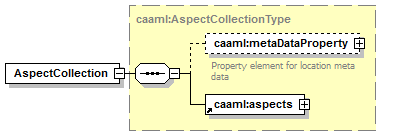
| content | complex |
| Name | Type | Use | Default | Fixed | Annotation | ||
| gml:id | optional |
|
<element name="AspectCollection" type="caaml:AspectCollectionType"/>
| schema location: | http://caaml.org/Schemas/V5.0/Profiles/BulletinEAWS/CAAMLv5_BulletinEAWS.xsd |
| attribute form default: | unqualified |
| element form default: | qualified |
| targetNamespace: | http://caaml.org/Schemas/V5.0/Profiles/BulletinEAWS |
| schema location: | http://caaml.org/Schemas/V5.0/Profiles/BulletinEAWS/CAAMLv5_BulletinEAWS_GML.xsd |
| attribute form default: | |
| element form default: | qualified |
| targetNamespace: | http://www.opengis.net/gml |
| schema location: | http://caaml.org/Schemas/V5.0/Profiles/BulletinEAWS/xlinks.xsd |
| attribute form default: | |
| element form default: | |
| targetNamespace: | http://www.w3.org/1999/xlink |
| Attr. groups |
| arcLink |
| emptyLink |
| extendedLink |
| locatorLink |
| resourceLink |
| simpleLink |
| titleLink |
| diagram |  |
||||||||||||||
| namespace | http://caaml.org/Schemas/V5.0/Profiles/BulletinEAWS | ||||||||||||||
| type | caaml:AspectCollectionType | ||||||||||||||
| properties |
|
||||||||||||||
| children | caaml:metaDataProperty caaml:aspects | ||||||||||||||
| attributes |
|
||||||||||||||
| source | <element name="AspectCollection" type="caaml:AspectCollectionType"/> |
| diagram |  |
||
| namespace | http://caaml.org/Schemas/V5.0/Profiles/BulletinEAWS | ||
| properties |
|
||
| children | caaml:AspectPosition caaml:AspectRange | ||
| used by |
|
||
| source | <element name="aspects"> <complexType> <sequence maxOccurs="unbounded"> <choice> <element name="AspectPosition"> <complexType> <complexContent> <extension base="caaml:AspectPositionType"/> </complexContent> </complexType> </element> <element name="AspectRange"> <complexType> <complexContent> <extension base="caaml:AspectRangeType"/> </complexContent> </complexType> </element> </choice> </sequence> </complexType> </element> |
| diagram |  |
||||||||||||||
| namespace | http://caaml.org/Schemas/V5.0/Profiles/BulletinEAWS | ||||||||||||||
| type | extension of caaml:AspectPositionType | ||||||||||||||
| properties |
|
||||||||||||||
| children | caaml:position | ||||||||||||||
| attributes |
|
||||||||||||||
| source | <element name="AspectPosition"> <complexType> <complexContent> <extension base="caaml:AspectPositionType"/> </complexContent> </complexType> </element> |
| diagram |  |
||||||||||||||
| namespace | http://caaml.org/Schemas/V5.0/Profiles/BulletinEAWS | ||||||||||||||
| type | extension of caaml:AspectRangeType | ||||||||||||||
| properties |
|
||||||||||||||
| children | caaml:beginPosition caaml:endPosition | ||||||||||||||
| attributes |
|
||||||||||||||
| source | <element name="AspectRange"> <complexType> <complexContent> <extension base="caaml:AspectRangeType"/> </complexContent> </complexType> </element> |
| diagram | 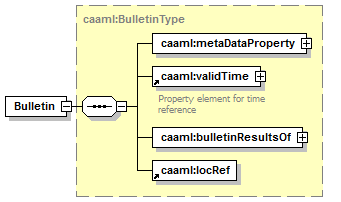 |
||||||||||||||
| namespace | http://caaml.org/Schemas/V5.0/Profiles/BulletinEAWS | ||||||||||||||
| type | caaml:BulletinType | ||||||||||||||
| properties |
|
||||||||||||||
| children | caaml:metaDataProperty caaml:validTime caaml:bulletinResultsOf caaml:locRef | ||||||||||||||
| used by |
|
||||||||||||||
| attributes |
|
||||||||||||||
| source | <element name="Bulletin" type="caaml:BulletinType"/> |
| diagram | 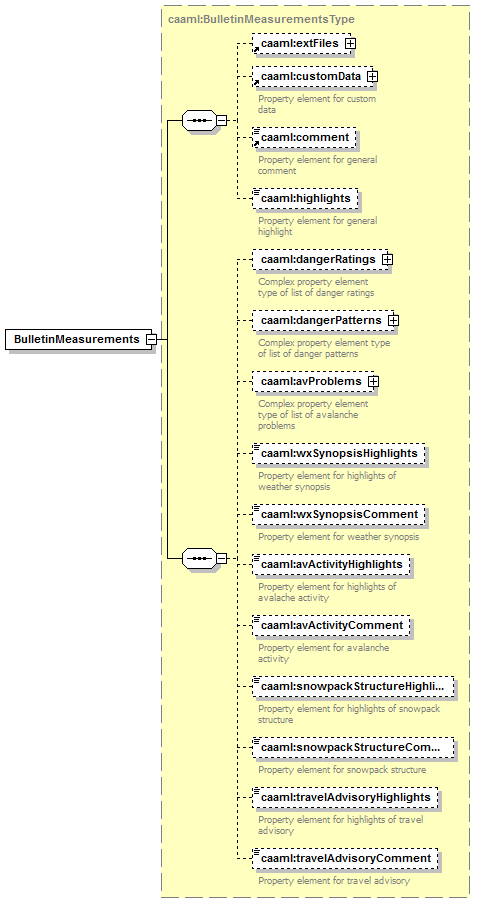 |
||
| namespace | http://caaml.org/Schemas/V5.0/Profiles/BulletinEAWS | ||
| type | caaml:BulletinMeasurementsType | ||
| properties |
|
||
| children | caaml:extFiles caaml:customData caaml:comment caaml:highlights caaml:dangerRatings caaml:wxSynopsisHighlights caaml:wxSynopsisComment caaml:avActivityHighlights caaml:avActivityComment caaml:snowpackStructureHighlights caaml:snowpackStructureComment caaml:travelAdvisoryHighlights caaml:travelAdvisoryComment | ||
| used by |
|
||
| source | <element name="BulletinMeasurements" type="caaml:BulletinMeasurementsType"/> |
| diagram | 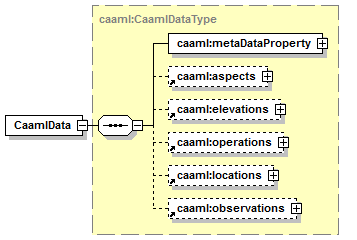 |
||
| namespace | http://caaml.org/Schemas/V5.0/Profiles/BulletinEAWS | ||
| type | caaml:CaamlDataType | ||
| properties |
|
||
| children | caaml:metaDataProperty caaml:aspects caaml:elevations caaml:operations caaml:locations caaml:observations | ||
| source | <element name="CaamlData" type="caaml:CaamlDataType"/> |
| diagram |  |
||||
| namespace | http://caaml.org/Schemas/V5.0/Profiles/BulletinEAWS | ||||
| type | string | ||||
| properties |
|
||||
| used by |
|
||||
| annotation |
|
||||
| source | <element name="comment" type="string"> <annotation> <documentation>Property element for general comment</documentation> </annotation> </element> |
| diagram |  |
||
| namespace | http://caaml.org/Schemas/V5.0/Profiles/BulletinEAWS | ||
| type | caaml:CustomDataType | ||
| properties |
|
||
| used by |
|
||
| annotation |
|
||
| source | <element name="customData" type="caaml:CustomDataType"> <annotation> <documentation>Property element for custom data</documentation> </annotation> </element> |
| diagram | 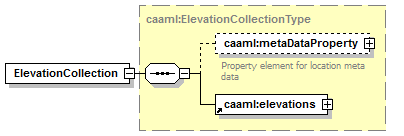 |
||||||||||||||
| namespace | http://caaml.org/Schemas/V5.0/Profiles/BulletinEAWS | ||||||||||||||
| type | caaml:ElevationCollectionType | ||||||||||||||
| properties |
|
||||||||||||||
| children | caaml:metaDataProperty caaml:elevations | ||||||||||||||
| attributes |
|
||||||||||||||
| source | <element name="ElevationCollection" type="caaml:ElevationCollectionType"/> |
| diagram |  |
||
| namespace | http://caaml.org/Schemas/V5.0/Profiles/BulletinEAWS | ||
| properties |
|
||
| children | caaml:ElevationPosition caaml:ElevationRange | ||
| used by |
|
||
| source | <element name="elevations"> <complexType> <sequence maxOccurs="unbounded"> <choice> <element name="ElevationPosition"> <complexType> <complexContent> <extension base="caaml:ElevationPositionType"/> </complexContent> </complexType> </element> <element name="ElevationRange"> <complexType> <complexContent> <extension base="caaml:ElevationRangeType"/> </complexContent> </complexType> </element> </choice> </sequence> </complexType> </element> |
| diagram |  |
||||||||||||||||||||
| namespace | http://caaml.org/Schemas/V5.0/Profiles/BulletinEAWS | ||||||||||||||||||||
| type | extension of caaml:ElevationPositionType | ||||||||||||||||||||
| properties |
|
||||||||||||||||||||
| children | caaml:position | ||||||||||||||||||||
| attributes |
|
||||||||||||||||||||
| source | <element name="ElevationPosition"> <complexType> <complexContent> <extension base="caaml:ElevationPositionType"/> </complexContent> </complexType> </element> |
| diagram |  |
||||||||||||||||||||
| namespace | http://caaml.org/Schemas/V5.0/Profiles/BulletinEAWS | ||||||||||||||||||||
| type | extension of caaml:ElevationRangeType | ||||||||||||||||||||
| properties |
|
||||||||||||||||||||
| children | caaml:beginPosition caaml:endPosition | ||||||||||||||||||||
| attributes |
|
||||||||||||||||||||
| source | <element name="ElevationRange"> <complexType> <complexContent> <extension base="caaml:ElevationRangeType"/> </complexContent> </complexType> </element> |
| diagram | 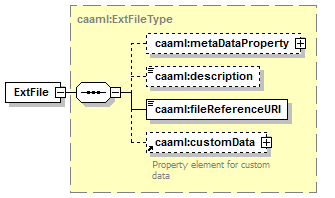 |
||||||||||||||
| namespace | http://caaml.org/Schemas/V5.0/Profiles/BulletinEAWS | ||||||||||||||
| type | caaml:ExtFileType | ||||||||||||||
| properties |
|
||||||||||||||
| children | caaml:metaDataProperty caaml:description caaml:fileReferenceURI caaml:customData | ||||||||||||||
| used by |
|
||||||||||||||
| attributes |
|
||||||||||||||
| source | <element name="ExtFile" type="caaml:ExtFileType"/> |
| diagram |  |
||
| namespace | http://caaml.org/Schemas/V5.0/Profiles/BulletinEAWS | ||
| properties |
|
||
| children | caaml:ExtFile | ||
| used by |
|
||
| source | <element name="extFiles"> <complexType> <sequence maxOccurs="unbounded"> <element ref="caaml:ExtFile"/> </sequence> </complexType> </element> |
| diagram | 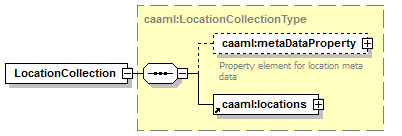 |
||||||||||||||
| namespace | http://caaml.org/Schemas/V5.0/Profiles/BulletinEAWS | ||||||||||||||
| type | caaml:LocationCollectionType | ||||||||||||||
| properties |
|
||||||||||||||
| children | caaml:metaDataProperty caaml:locations | ||||||||||||||
| attributes |
|
||||||||||||||
| source | <element name="LocationCollection" type="caaml:LocationCollectionType"/> |
| diagram | |||
| namespace | http://caaml.org/Schemas/V5.0/Profiles/BulletinEAWS | ||
| properties |
|
||
| children | caaml:Region | ||
| used by |
|
||
| source | <element name="locations"> <complexType> <sequence maxOccurs="unbounded"> <element name="Region"/> </sequence> </complexType> </element> |
| diagram | |||
| namespace | http://caaml.org/Schemas/V5.0/Profiles/BulletinEAWS | ||
| properties |
|
||
| source | <element name="Region"/> |
| diagram |  |
||||||||||||
| namespace | http://caaml.org/Schemas/V5.0/Profiles/BulletinEAWS | ||||||||||||
| type | caaml:LocRefType | ||||||||||||
| properties |
|
||||||||||||
| used by |
|
||||||||||||
| attributes |
|
||||||||||||
| source | <element name="locRef" type="caaml:LocRefType"/> |
| diagram |  |
||||||||||||||
| namespace | http://caaml.org/Schemas/V5.0/Profiles/BulletinEAWS | ||||||||||||||
| type | caaml:ObsCollectionType | ||||||||||||||
| properties |
|
||||||||||||||
| children | caaml:metaDataProperty caaml:observations | ||||||||||||||
| attributes |
|
||||||||||||||
| source | <element name="ObsCollection" type="caaml:ObsCollectionType"/> |
| diagram |  |
||
| namespace | http://caaml.org/Schemas/V5.0/Profiles/BulletinEAWS | ||
| properties |
|
||
| children | caaml:Bulletin | ||
| used by |
|
||
| source | <element name="observations"> <complexType> <sequence maxOccurs="unbounded"> <element ref="caaml:Bulletin"/> </sequence> </complexType> </element> |
| diagram | 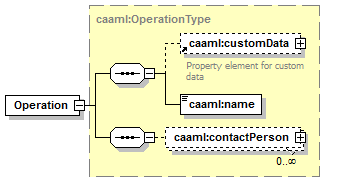 |
||||||||||||||
| namespace | http://caaml.org/Schemas/V5.0/Profiles/BulletinEAWS | ||||||||||||||
| type | caaml:OperationType | ||||||||||||||
| properties |
|
||||||||||||||
| children | caaml:customData caaml:name caaml:contactPerson | ||||||||||||||
| used by |
|
||||||||||||||
| attributes |
|
||||||||||||||
| source | <element name="Operation" type="caaml:OperationType"/> |
| diagram |  |
||||||||||||||
| namespace | http://caaml.org/Schemas/V5.0/Profiles/BulletinEAWS | ||||||||||||||
| type | caaml:OperationCollectionType | ||||||||||||||
| properties |
|
||||||||||||||
| children | caaml:metaDataProperty caaml:operations | ||||||||||||||
| attributes |
|
||||||||||||||
| source | <element name="OperationCollection" type="caaml:OperationCollectionType"/> |
| diagram |  |
||
| namespace | http://caaml.org/Schemas/V5.0/Profiles/BulletinEAWS | ||
| properties |
|
||
| children | caaml:Operation | ||
| used by |
|
||
| source | <element name="operations"> <complexType> <sequence maxOccurs="unbounded"> <element ref="caaml:Operation"/> </sequence> </complexType> </element> |
| diagram | 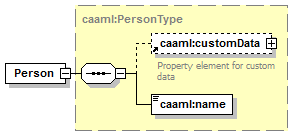 |
||||||||||||||
| namespace | http://caaml.org/Schemas/V5.0/Profiles/BulletinEAWS | ||||||||||||||
| type | caaml:PersonType | ||||||||||||||
| properties |
|
||||||||||||||
| children | caaml:customData caaml:name | ||||||||||||||
| used by |
|
||||||||||||||
| attributes |
|
||||||||||||||
| source | <element name="Person" type="caaml:PersonType"/> |
| diagram | 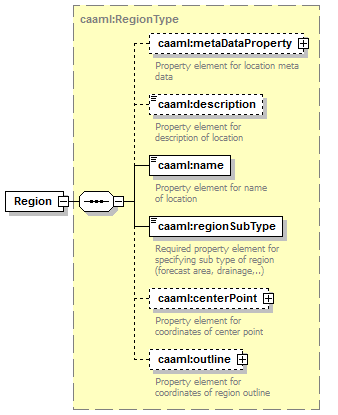 |
||||||||||||||
| namespace | http://caaml.org/Schemas/V5.0/Profiles/BulletinEAWS | ||||||||||||||
| type | caaml:RegionType | ||||||||||||||
| properties |
|
||||||||||||||
| children | caaml:metaDataProperty caaml:description caaml:name caaml:regionSubType caaml:centerPoint caaml:outline | ||||||||||||||
| attributes |
|
||||||||||||||
| source | <element name="Region" type="caaml:RegionType"/> |
| diagram |  |
||||||||||||||
| namespace | http://caaml.org/Schemas/V5.0/Profiles/BulletinEAWS | ||||||||||||||
| type | caaml:TimeInstantType | ||||||||||||||
| properties |
|
||||||||||||||
| children | caaml:timePosition | ||||||||||||||
| used by |
|
||||||||||||||
| attributes |
|
||||||||||||||
| source | <element name="TimeInstant" type="caaml:TimeInstantType"/> |
| diagram |  |
||||||||||||||
| namespace | http://caaml.org/Schemas/V5.0/Profiles/BulletinEAWS | ||||||||||||||
| type | caaml:TimePeriodType | ||||||||||||||
| properties |
|
||||||||||||||
| children | caaml:beginPosition caaml:endPosition | ||||||||||||||
| used by |
|
||||||||||||||
| attributes |
|
||||||||||||||
| source | <element name="TimePeriod" type="caaml:TimePeriodType"/> |
| diagram |  |
||||||||||||
| namespace | http://caaml.org/Schemas/V5.0/Profiles/BulletinEAWS | ||||||||||||
| type | caaml:ValidAspectType | ||||||||||||
| properties |
|
||||||||||||
| used by |
|
||||||||||||
| attributes |
|
||||||||||||
| annotation |
|
||||||||||||
| source | <element name="validAspect" type="caaml:ValidAspectType"> <annotation> <documentation>Property element for aspect of location</documentation> </annotation> </element> |
| diagram |  |
||||||||||||
| namespace | http://caaml.org/Schemas/V5.0/Profiles/BulletinEAWS | ||||||||||||
| type | caaml:ValidElevationType | ||||||||||||
| properties |
|
||||||||||||
| children | caaml:ElevationPosition caaml:ElevationRange | ||||||||||||
| used by |
|
||||||||||||
| attributes |
|
||||||||||||
| annotation |
|
||||||||||||
| source | <element name="validElevation" type="caaml:ValidElevationType"> <annotation> <documentation>Property element for elevation of location</documentation> </annotation> </element> |
| diagram |  |
||||
| namespace | http://caaml.org/Schemas/V5.0/Profiles/BulletinEAWS | ||||
| type | caaml:ValidTimeType | ||||
| properties |
|
||||
| children | caaml:TimeInstant caaml:TimePeriod | ||||
| used by |
|
||||
| annotation |
|
||||
| source | <element name="validTime" type="caaml:ValidTimeType"> <annotation> <documentation>Property element for time reference</documentation> </annotation> </element> |
| diagram |  |
||
| namespace | http://caaml.org/Schemas/V5.0/Profiles/BulletinEAWS | ||
| children | caaml:metaDataProperty caaml:aspects | ||
| used by |
|
||
| attributes | |||
| source | <complexType name="AspectCollectionType"> <sequence> <element name="metaDataProperty" minOccurs="0"> <annotation> <documentation>Property element for location meta data</documentation> </annotation> <complexType> <sequence> <element name="MetaData" type="caaml:LocMetaDataType"/> </sequence> </complexType> </element> <element ref="caaml:aspects"/> </sequence> <attribute ref="gml:id" use="optional"/> </complexType> |
| diagram |  |
||||
| namespace | http://caaml.org/Schemas/V5.0/Profiles/BulletinEAWS | ||||
| properties |
|
||||
| children | caaml:MetaData | ||||
| annotation |
|
||||
| source | <element name="metaDataProperty" minOccurs="0"> <annotation> <documentation>Property element for location meta data</documentation> </annotation> <complexType> <sequence> <element name="MetaData" type="caaml:LocMetaDataType"/> </sequence> </complexType> </element> |
| diagram | 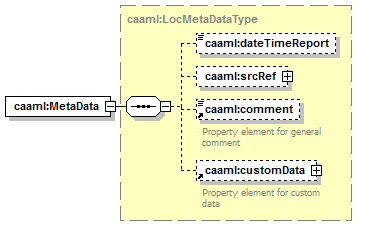 |
||||
| namespace | http://caaml.org/Schemas/V5.0/Profiles/BulletinEAWS | ||||
| type | caaml:LocMetaDataType | ||||
| properties |
|
||||
| children | caaml:dateTimeReport caaml:srcRef caaml:comment caaml:customData | ||||
| source | <element name="MetaData" type="caaml:LocMetaDataType"/> |
| diagram |  |
||||||||||||||
| namespace | http://caaml.org/Schemas/V5.0/Profiles/BulletinEAWS | ||||||||||||||
| children | caaml:position | ||||||||||||||
| used by |
|
||||||||||||||
| attributes |
|
||||||||||||||
| source | <complexType name="AspectPositionType"> <sequence> <element name="position" type="caaml:AspectBaseType"/> </sequence> <attribute ref="gml:id" use="required"/> </complexType> |
| diagram |  |
||||
| namespace | http://caaml.org/Schemas/V5.0/Profiles/BulletinEAWS | ||||
| type | caaml:AspectBaseType | ||||
| properties |
|
||||
| source | <element name="position" type="caaml:AspectBaseType"/> |
| diagram |  |
||||||||||||||
| namespace | http://caaml.org/Schemas/V5.0/Profiles/BulletinEAWS | ||||||||||||||
| children | caaml:beginPosition caaml:endPosition | ||||||||||||||
| used by |
|
||||||||||||||
| attributes |
|
||||||||||||||
| source | <complexType name="AspectRangeType"> <sequence> <element name="beginPosition" type="caaml:AspectBaseType"/> <element name="endPosition" type="caaml:AspectBaseType"/> </sequence> <attribute ref="gml:id" use="required"/> </complexType> |
| diagram |  |
||||
| namespace | http://caaml.org/Schemas/V5.0/Profiles/BulletinEAWS | ||||
| type | caaml:AspectBaseType | ||||
| properties |
|
||||
| source | <element name="beginPosition" type="caaml:AspectBaseType"/> |
| diagram |  |
||||
| namespace | http://caaml.org/Schemas/V5.0/Profiles/BulletinEAWS | ||||
| type | caaml:AspectBaseType | ||||
| properties |
|
||||
| source | <element name="endPosition" type="caaml:AspectBaseType"/> |
| diagram | 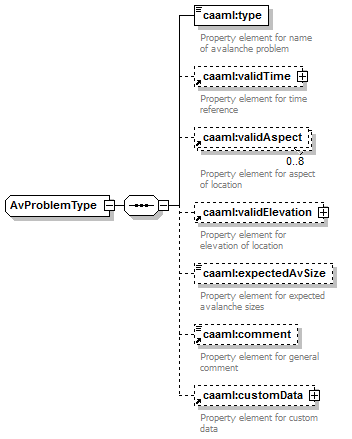 |
||||
| namespace | http://caaml.org/Schemas/V5.0/Profiles/BulletinEAWS | ||||
| type | extension of caaml:ObsMeasurementsType | ||||
| properties |
|
||||
| children | caaml:extFiles caaml:customData caaml:comment caaml:highlights caaml:dangerRatings caaml:wxSynopsisHighlights caaml:wxSynopsisComment caaml:avActivityHighlights caaml:avActivityComment caaml:snowpackStructureHighlights caaml:snowpackStructureComment caaml:travelAdvisoryHighlights caaml:travelAdvisoryComment | ||||
| used by |
|
||||
| source | <complexType name="BulletinMeasurementsType" final="#all"> <complexContent> <extension base="caaml:ObsMeasurementsType"> <sequence> <element name="dangerRatings" type="caaml:DangerRatingsType" minOccurs="0"> <annotation> <documentation>Complex property element type for danger ratings</documentation> </annotation> </element> <element name="wxSynopsisHighlights" type="string" minOccurs="0"> <annotation> <documentation>Property element for highlights of weather synopsis</documentation> </annotation> </element> <element name="wxSynopsisComment" type="string" minOccurs="0"> <annotation> <documentation>Property element for weather synopsis</documentation> </annotation> </element> <element name="avActivityHighlights" type="string" minOccurs="0"> <annotation> <documentation>Property element for highlights of avalache activity</documentation> </annotation> </element> <element name="avActivityComment" type="string" minOccurs="0"> <annotation> <documentation>Property element for avalanche activity</documentation> </annotation> </element> <element name="snowpackStructureHighlights" type="string" minOccurs="0"> <annotation> <documentation>Property element for highlights of snowpack structure</documentation> </annotation> </element> <element name="snowpackStructureComment" type="string" minOccurs="0"> <annotation> <documentation>Property element for snowpack structure</documentation> </annotation> </element> <element name="travelAdvisoryHighlights" type="string" minOccurs="0"> <annotation> <documentation>Property element for highlights of travel advisory</documentation> </annotation> </element> <element name="travelAdvisoryComment" type="string" minOccurs="0"> <annotation> <documentation>Property element for travel advisory</documentation> </annotation> </element> </sequence> </extension> </complexContent> </complexType> |
| diagram |  |
||||
| namespace | http://caaml.org/Schemas/V5.0/Profiles/BulletinEAWS | ||||
| type | caaml:DangerRatingsType | ||||
| properties |
|
||||
| children | caaml:DangerRating | ||||
| annotation |
|
||||
| source | <element name="dangerRatings" type="caaml:DangerRatingsType" minOccurs="0"> <annotation> <documentation>Complex property element type for danger ratings</documentation> </annotation> </element> |
| diagram |  |
||||
| namespace | http://caaml.org/Schemas/V5.0/Profiles/BulletinEAWS | ||||
| type | string | ||||
| properties |
|
||||
| annotation |
|
||||
| source | <element name="wxSynopsisHighlights" type="string" minOccurs="0"> <annotation> <documentation>Property element for highlights of weather synopsis</documentation> </annotation> </element> |
| diagram | 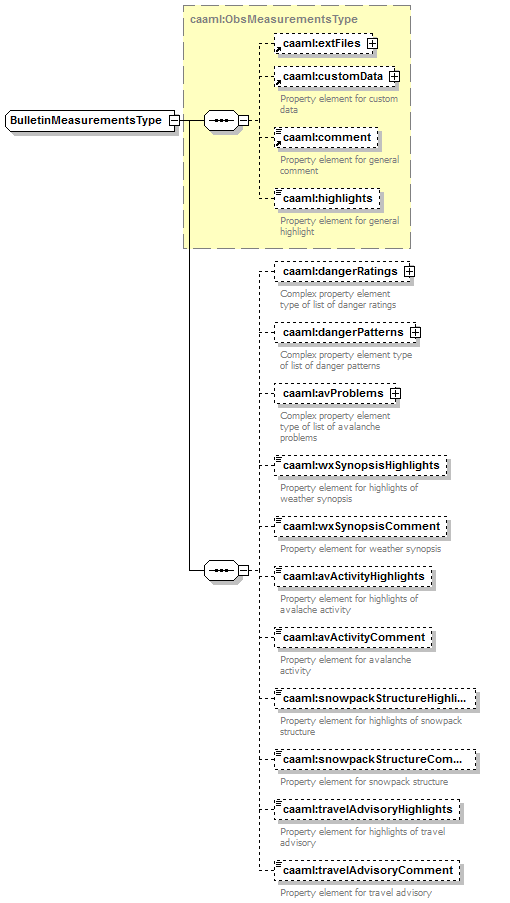 |
||||
| namespace | http://caaml.org/Schemas/V5.0/Profiles/BulletinEAWS | ||||
| type | string | ||||
| properties |
|
||||
| annotation |
|
||||
| source | <element name="wxSynopsisComment" type="string" minOccurs="0"> <annotation> <documentation>Property element for weather synopsis</documentation> </annotation> </element> |
| diagram |  |
||||
| namespace | http://caaml.org/Schemas/V5.0/Profiles/BulletinEAWS | ||||
| type | string | ||||
| properties |
|
||||
| annotation |
|
||||
| source | <element name="avActivityHighlights" type="string" minOccurs="0"> <annotation> <documentation>Property element for highlights of avalache activity</documentation> </annotation> </element> |
| diagram | 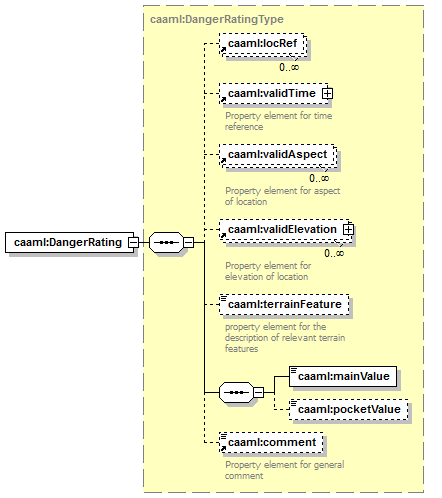 |
||||
| namespace | http://caaml.org/Schemas/V5.0/Profiles/BulletinEAWS | ||||
| type | string | ||||
| properties |
|
||||
| annotation |
|
||||
| source | <element name="avActivityComment" type="string" minOccurs="0"> <annotation> <documentation>Property element for avalanche activity</documentation> </annotation> </element> |
| diagram |  |
||||
| namespace | http://caaml.org/Schemas/V5.0/Profiles/BulletinEAWS | ||||
| type | string | ||||
| properties |
|
||||
| annotation |
|
||||
| source | <element name="snowpackStructureHighlights" type="string" minOccurs="0"> <annotation> <documentation>Property element for highlights of snowpack structure</documentation> </annotation> </element> |
| diagram | 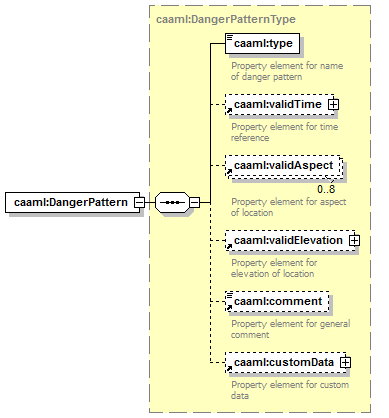 |
||||
| namespace | http://caaml.org/Schemas/V5.0/Profiles/BulletinEAWS | ||||
| type | string | ||||
| properties |
|
||||
| annotation |
|
||||
| source | <element name="snowpackStructureComment" type="string" minOccurs="0"> <annotation> <documentation>Property element for snowpack structure</documentation> </annotation> </element> |
| diagram |  |
||||
| namespace | http://caaml.org/Schemas/V5.0/Profiles/BulletinEAWS | ||||
| type | string | ||||
| properties |
|
||||
| annotation |
|
||||
| source | <element name="travelAdvisoryHighlights" type="string" minOccurs="0"> <annotation> <documentation>Property element for highlights of travel advisory</documentation> </annotation> </element> |
| diagram | 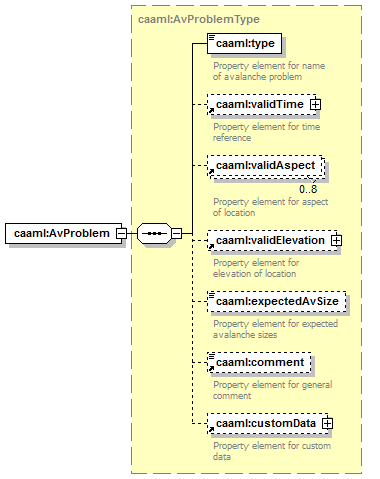 |
||||
| namespace | http://caaml.org/Schemas/V5.0/Profiles/BulletinEAWS | ||||
| type | string | ||||
| properties |
|
||||
| annotation |
|
||||
| source | <element name="travelAdvisoryComment" type="string" minOccurs="0"> <annotation> <documentation>Property element for travel advisory</documentation> </annotation> </element> |
| diagram |  |
||||||||||||||
| namespace | http://caaml.org/Schemas/V5.0/Profiles/BulletinEAWS | ||||||||||||||
| properties |
|
||||||||||||||
| children | caaml:metaDataProperty caaml:validTime caaml:bulletinResultsOf caaml:locRef | ||||||||||||||
| used by |
|
||||||||||||||
| attributes |
|
||||||||||||||
| source | <complexType name="BulletinType" final="#all"> <sequence> <element name="metaDataProperty"> <complexType> <sequence> <element name="MetaData" type="caaml:ObsMetaDataType"/> </sequence> </complexType> </element> <element ref="caaml:validTime"/> <element name="bulletinResultsOf"> <complexType> <sequence> <element ref="caaml:BulletinMeasurements"/> </sequence> </complexType> </element> <element ref="caaml:locRef"/> </sequence> <attribute ref="gml:id" use="required"/> </complexType> |
| diagram |  |
||||
| namespace | http://caaml.org/Schemas/V5.0/Profiles/BulletinEAWS | ||||
| properties |
|
||||
| children | caaml:MetaData | ||||
| source | <element name="metaDataProperty"> <complexType> <sequence> <element name="MetaData" type="caaml:ObsMetaDataType"/> </sequence> </complexType> </element> |
| diagram |  |
||||
| namespace | http://caaml.org/Schemas/V5.0/Profiles/BulletinEAWS | ||||
| type | caaml:ObsMetaDataType | ||||
| properties |
|
||||
| children | caaml:dateTimeReport caaml:srcRef caaml:comment caaml:customData | ||||
| source | <element name="MetaData" type="caaml:ObsMetaDataType"/> |
| diagram |  |
||||
| namespace | http://caaml.org/Schemas/V5.0/Profiles/BulletinEAWS | ||||
| properties |
|
||||
| children | caaml:BulletinMeasurements | ||||
| source | <element name="bulletinResultsOf"> <complexType> <sequence> <element ref="caaml:BulletinMeasurements"/> </sequence> </complexType> </element> |
| diagram |  |
||
| namespace | http://caaml.org/Schemas/V5.0/Profiles/BulletinEAWS | ||
| children | caaml:metaDataProperty caaml:aspects caaml:elevations caaml:operations caaml:locations caaml:observations | ||
| used by |
|
||
| source | <complexType name="CaamlDataType"> <sequence> <element name="metaDataProperty"> <complexType> <sequence> <element name="MetaData" type="caaml:CaamlMetaDataType"/> </sequence> </complexType> </element> <element ref="caaml:aspects" minOccurs="0"/> <element ref="caaml:elevations" minOccurs="0"/> <element ref="caaml:operations" minOccurs="0"/> <element ref="caaml:locations" minOccurs="0"/> <element ref="caaml:observations" minOccurs="0"/> </sequence> </complexType> |
| diagram |  |
||||
| namespace | http://caaml.org/Schemas/V5.0/Profiles/BulletinEAWS | ||||
| properties |
|
||||
| children | caaml:MetaData | ||||
| source | <element name="metaDataProperty"> <complexType> <sequence> <element name="MetaData" type="caaml:CaamlMetaDataType"/> </sequence> </complexType> </element> |
| diagram |  |
||||
| namespace | http://caaml.org/Schemas/V5.0/Profiles/BulletinEAWS | ||||
| type | caaml:CaamlMetaDataType | ||||
| properties |
|
||||
| children | caaml:dateTimeReport caaml:srcRef caaml:comment caaml:customData | ||||
| source | <element name="MetaData" type="caaml:CaamlMetaDataType"/> |
| diagram |  |
||
| namespace | http://caaml.org/Schemas/V5.0/Profiles/BulletinEAWS | ||
| type | restriction of caaml:MetaDataBaseType | ||
| properties |
|
||
| children | caaml:dateTimeReport caaml:srcRef caaml:comment caaml:customData | ||
| used by |
|
||
| source | <complexType name="CaamlMetaDataType"> <complexContent> <restriction base="caaml:MetaDataBaseType"> <sequence> <element name="dateTimeReport" type="gml:TimePositionType"/> <element name="srcRef" type="caaml:SourceRefType"/> <element ref="caaml:comment" minOccurs="0"/> <element ref="caaml:customData" minOccurs="0"/> </sequence> </restriction> </complexContent> </complexType> |
| diagram | 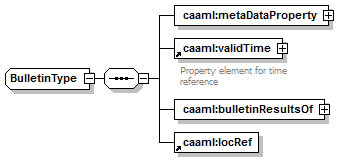 |
||||
| namespace | http://caaml.org/Schemas/V5.0/Profiles/BulletinEAWS | ||||
| type | gml:TimePositionType | ||||
| properties |
|
||||
| source | <element name="dateTimeReport" type="gml:TimePositionType"/> |
| diagram |  |
||||||||||||
| namespace | http://caaml.org/Schemas/V5.0/Profiles/BulletinEAWS | ||||||||||||
| type | caaml:SourceRefType | ||||||||||||
| properties |
|
||||||||||||
| children | caaml:Operation | ||||||||||||
| attributes |
|
||||||||||||
| source | <element name="srcRef" type="caaml:SourceRefType"/> |
| diagram | |||
| namespace | http://caaml.org/Schemas/V5.0/Profiles/BulletinEAWS | ||
| properties |
|
||
| used by |
|
||
| source | <complexType name="CustomDataType" final="#all"> <sequence> <any namespace="##other" processContents="lax" minOccurs="0" maxOccurs="unbounded"/> </sequence> </complexType> |
| diagram | |||
| namespace | http://caaml.org/Schemas/V5.0/Profiles/BulletinEAWS | ||
| children | caaml:DangerRating | ||
| used by |
|
||
| source | <complexType name="DangerRatingsType"> <sequence> <element name="DangerRating" maxOccurs="unbounded"> <complexType> <sequence> <element ref="caaml:locRef" minOccurs="0" maxOccurs="unbounded"/> <element ref="caaml:validTime" minOccurs="0"/> <element ref="caaml:validAspect" minOccurs="0" maxOccurs="unbounded"/> <element ref="caaml:validElevation" minOccurs="0" maxOccurs="unbounded"/> <element name="terrainFeature" type="string" minOccurs="0"> <annotation> <documentation>property element for the description of relevant terrain features</documentation> </annotation> </element> <sequence> <element name="mainValue" type="caaml:DangerRatingValueType"/> <element name="pocketValue" type="caaml:DangerRatingValueType" minOccurs="0"/> </sequence> <element ref="caaml:comment" minOccurs="0"/> </sequence> </complexType> </element> </sequence> </complexType> |
| diagram | 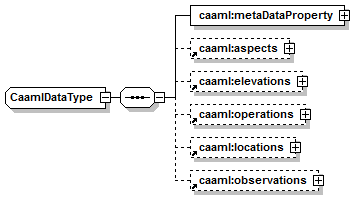 |
||||
| namespace | http://caaml.org/Schemas/V5.0/Profiles/BulletinEAWS | ||||
| properties |
|
||||
| children | caaml:locRef caaml:validTime caaml:validAspect caaml:validElevation caaml:terrainFeature caaml:mainValue caaml:pocketValue caaml:comment | ||||
| source | <element name="DangerRating" maxOccurs="unbounded"> <complexType> <sequence> <element ref="caaml:locRef" minOccurs="0" maxOccurs="unbounded"/> <element ref="caaml:validTime" minOccurs="0"/> <element ref="caaml:validAspect" minOccurs="0" maxOccurs="unbounded"/> <element ref="caaml:validElevation" minOccurs="0" maxOccurs="unbounded"/> <element name="terrainFeature" type="string" minOccurs="0"> <annotation> <documentation>property element for the description of relevant terrain features</documentation> </annotation> </element> <sequence> <element name="mainValue" type="caaml:DangerRatingValueType"/> <element name="pocketValue" type="caaml:DangerRatingValueType" minOccurs="0"/> </sequence> <element ref="caaml:comment" minOccurs="0"/> </sequence> </complexType> </element> |
| diagram |  |
||||
| namespace | http://caaml.org/Schemas/V5.0/Profiles/BulletinEAWS | ||||
| type | string | ||||
| properties |
|
||||
| annotation |
|
||||
| source | <element name="terrainFeature" type="string" minOccurs="0"> <annotation> <documentation>property element for the description of relevant terrain features</documentation> </annotation> </element> |
| diagram | 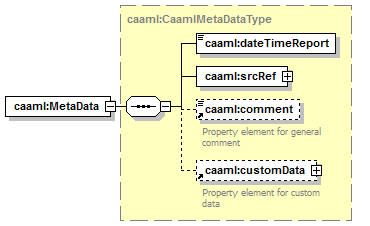 |
||||
| namespace | http://caaml.org/Schemas/V5.0/Profiles/BulletinEAWS | ||||
| type | caaml:DangerRatingValueType | ||||
| properties |
|
||||
| source | <element name="mainValue" type="caaml:DangerRatingValueType"/> |
| diagram | 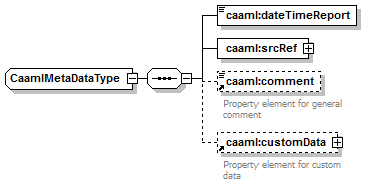 |
||||
| namespace | http://caaml.org/Schemas/V5.0/Profiles/BulletinEAWS | ||||
| type | caaml:DangerRatingValueType | ||||
| properties |
|
||||
| source | <element name="pocketValue" type="caaml:DangerRatingValueType" minOccurs="0"/> |
| diagram |  |
||||||||||||||
| namespace | http://caaml.org/Schemas/V5.0/Profiles/BulletinEAWS | ||||||||||||||
| children | caaml:metaDataProperty caaml:elevations | ||||||||||||||
| used by |
|
||||||||||||||
| attributes |
|
||||||||||||||
| source | <complexType name="ElevationCollectionType"> <sequence> <element name="metaDataProperty" minOccurs="0"> <annotation> <documentation>Property element for location meta data</documentation> </annotation> <complexType> <sequence> <element name="MetaData" type="caaml:LocMetaDataType"/> </sequence> </complexType> </element> <element ref="caaml:elevations"/> </sequence> <attribute ref="gml:id" use="optional"/> </complexType> |
| diagram |  |
||||
| namespace | http://caaml.org/Schemas/V5.0/Profiles/BulletinEAWS | ||||
| properties |
|
||||
| children | caaml:MetaData | ||||
| annotation |
|
||||
| source | <element name="metaDataProperty" minOccurs="0"> <annotation> <documentation>Property element for location meta data</documentation> </annotation> <complexType> <sequence> <element name="MetaData" type="caaml:LocMetaDataType"/> </sequence> </complexType> </element> |
| diagram |  |
||||
| namespace | http://caaml.org/Schemas/V5.0/Profiles/BulletinEAWS | ||||
| type | caaml:LocMetaDataType | ||||
| properties |
|
||||
| children | caaml:dateTimeReport caaml:srcRef caaml:comment caaml:customData | ||||
| source | <element name="MetaData" type="caaml:LocMetaDataType"/> |
| diagram | 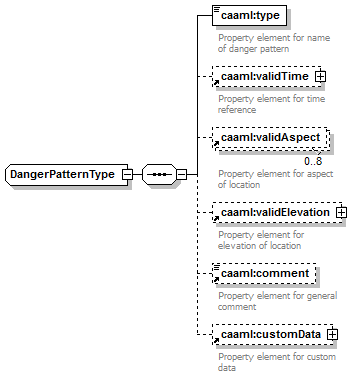 |
||||||||||||||||||||
| namespace | http://caaml.org/Schemas/V5.0/Profiles/BulletinEAWS | ||||||||||||||||||||
| children | caaml:position | ||||||||||||||||||||
| used by |
|
||||||||||||||||||||
| attributes |
|
||||||||||||||||||||
| source | <complexType name="ElevationPositionType"> <sequence> <element name="position" type="caaml:ElevationBaseType"/> </sequence> <attribute name="uom" type="caaml:UomLengthType" use="required" fixed="m"/> <attribute ref="gml:id" use="optional"/> </complexType> |
| diagram |  |
||||
| namespace | http://caaml.org/Schemas/V5.0/Profiles/BulletinEAWS | ||||
| type | caaml:ElevationBaseType | ||||
| properties |
|
||||
| facets |
|
||||
| source | <element name="position" type="caaml:ElevationBaseType"/> |
| diagram | 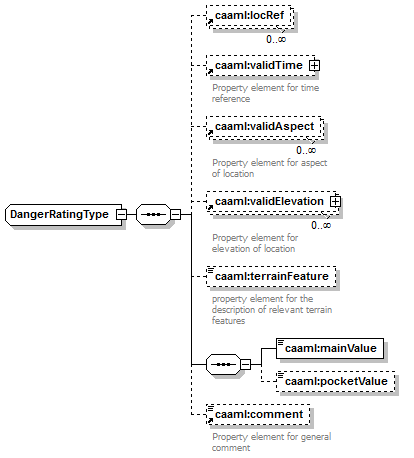 |
||||||||||||||||||||
| namespace | http://caaml.org/Schemas/V5.0/Profiles/BulletinEAWS | ||||||||||||||||||||
| children | caaml:beginPosition caaml:endPosition | ||||||||||||||||||||
| used by |
|
||||||||||||||||||||
| attributes |
|
||||||||||||||||||||
| source | <complexType name="ElevationRangeType"> <sequence> <element name="beginPosition" type="caaml:ElevationBaseType" minOccurs="0"/> <element name="endPosition" type="caaml:ElevationBaseType" minOccurs="0"/> </sequence> <attribute name="uom" type="caaml:UomLengthType" use="required" fixed="m"/> <attribute ref="gml:id" use="optional"/> </complexType> |
| diagram |  |
||||
| namespace | http://caaml.org/Schemas/V5.0/Profiles/BulletinEAWS | ||||
| type | caaml:ElevationBaseType | ||||
| properties |
|
||||
| facets |
|
||||
| source | <element name="beginPosition" type="caaml:ElevationBaseType" minOccurs="0"/> |
| diagram |  |
||||
| namespace | http://caaml.org/Schemas/V5.0/Profiles/BulletinEAWS | ||||
| type | caaml:ElevationBaseType | ||||
| properties |
|
||||
| facets |
|
||||
| source | <element name="endPosition" type="caaml:ElevationBaseType" minOccurs="0"/> |
| diagram |  |
||
| namespace | http://caaml.org/Schemas/V5.0/Profiles/BulletinEAWS | ||
| type | extension of caaml:MetaDataBaseType | ||
| properties |
|
||
| children | caaml:dateTimeReport caaml:srcRef caaml:comment caaml:customData | ||
| used by |
|
||
| source | <complexType name="ExtFileMetaDataType"> <complexContent> <extension base="caaml:MetaDataBaseType"/> </complexContent> </complexType> |
| diagram |  |
||||||||||||||
| namespace | http://caaml.org/Schemas/V5.0/Profiles/BulletinEAWS | ||||||||||||||
| children | caaml:metaDataProperty caaml:description caaml:fileReferenceURI caaml:customData | ||||||||||||||
| used by |
|
||||||||||||||
| attributes |
|
||||||||||||||
| source | <complexType name="ExtFileType"> <sequence> <element name="metaDataProperty" minOccurs="0"> <complexType> <sequence> <element name="MetaData" type="caaml:ExtFileMetaDataType"/> </sequence> </complexType> </element> <element name="description" type="string" minOccurs="0"/> <element name="fileReferenceURI" type="anyURI"/> <element ref="caaml:customData" minOccurs="0"/> </sequence> <attribute ref="gml:id" use="required"/> </complexType> |
| diagram |  |
||||
| namespace | http://caaml.org/Schemas/V5.0/Profiles/BulletinEAWS | ||||
| properties |
|
||||
| children | caaml:MetaData | ||||
| source | <element name="metaDataProperty" minOccurs="0"> <complexType> <sequence> <element name="MetaData" type="caaml:ExtFileMetaDataType"/> </sequence> </complexType> </element> |
| diagram | 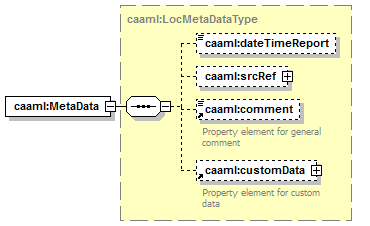 |
||||
| namespace | http://caaml.org/Schemas/V5.0/Profiles/BulletinEAWS | ||||
| type | caaml:ExtFileMetaDataType | ||||
| properties |
|
||||
| children | caaml:dateTimeReport caaml:srcRef caaml:comment caaml:customData | ||||
| source | <element name="MetaData" type="caaml:ExtFileMetaDataType"/> |
| diagram |  |
||||
| namespace | http://caaml.org/Schemas/V5.0/Profiles/BulletinEAWS | ||||
| type | string | ||||
| properties |
|
||||
| source | <element name="description" type="string" minOccurs="0"/> |
| diagram |  |
||||
| namespace | http://caaml.org/Schemas/V5.0/Profiles/BulletinEAWS | ||||
| type | anyURI | ||||
| properties |
|
||||
| source | <element name="fileReferenceURI" type="anyURI"/> |
| diagram |  |
||||||||||||||
| namespace | http://caaml.org/Schemas/V5.0/Profiles/BulletinEAWS | ||||||||||||||
| children | caaml:metaDataProperty caaml:locations | ||||||||||||||
| used by |
|
||||||||||||||
| attributes |
|
||||||||||||||
| source | <complexType name="LocationCollectionType"> <sequence> <element name="metaDataProperty" minOccurs="0"> <annotation> <documentation>Property element for location meta data</documentation> </annotation> <complexType> <sequence> <element name="MetaData" type="caaml:LocMetaDataType"/> </sequence> </complexType> </element> <element ref="caaml:locations"/> </sequence> <attribute ref="gml:id" use="optional"/> </complexType> |
| diagram |  |
||||
| namespace | http://caaml.org/Schemas/V5.0/Profiles/BulletinEAWS | ||||
| properties |
|
||||
| children | caaml:MetaData | ||||
| annotation |
|
||||
| source | <element name="metaDataProperty" minOccurs="0"> <annotation> <documentation>Property element for location meta data</documentation> </annotation> <complexType> <sequence> <element name="MetaData" type="caaml:LocMetaDataType"/> </sequence> </complexType> </element> |
| diagram |  |
||||
| namespace | http://caaml.org/Schemas/V5.0/Profiles/BulletinEAWS | ||||
| type | caaml:LocMetaDataType | ||||
| properties |
|
||||
| children | caaml:dateTimeReport caaml:srcRef caaml:comment caaml:customData | ||||
| source | <element name="MetaData" type="caaml:LocMetaDataType"/> |
| diagram | 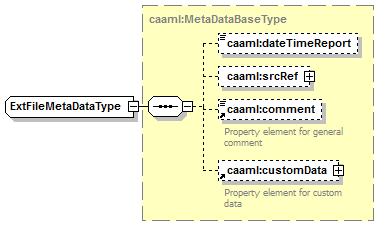 |
||
| namespace | http://caaml.org/Schemas/V5.0/Profiles/BulletinEAWS | ||
| type | extension of caaml:MetaDataBaseType | ||
| properties |
|
||
| children | caaml:dateTimeReport caaml:srcRef caaml:comment caaml:customData | ||
| used by |
|
||
| source | <complexType name="LocMetaDataType"> <complexContent> <extension base="caaml:MetaDataBaseType"/> </complexContent> </complexType> |
| diagram | |||||||||||||
| namespace | http://caaml.org/Schemas/V5.0/Profiles/BulletinEAWS | ||||||||||||
| used by |
|
||||||||||||
| attributes |
|
||||||||||||
| source | <complexType name="LocRefType"> <attribute ref="xlink:href" use="required"/> </complexType> |
| diagram |  |
||||
| namespace | http://caaml.org/Schemas/V5.0/Profiles/BulletinEAWS | ||||
| children | caaml:dateTimeReport caaml:srcRef caaml:comment caaml:customData | ||||
| used by |
|
||||
| source | <complexType name="MetaDataBaseType"> <sequence> <element name="dateTimeReport" type="gml:TimePositionType" minOccurs="0"/> <element name="srcRef" type="caaml:SourceRefType" minOccurs="0"/> <element ref="caaml:comment" minOccurs="0"/> <element ref="caaml:customData" minOccurs="0"/> </sequence> </complexType> |
| diagram | 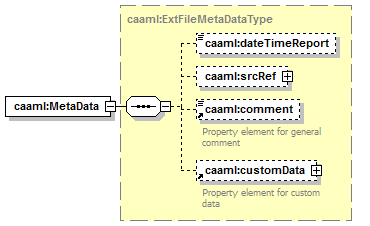 |
||||
| namespace | http://caaml.org/Schemas/V5.0/Profiles/BulletinEAWS | ||||
| type | gml:TimePositionType | ||||
| properties |
|
||||
| source | <element name="dateTimeReport" type="gml:TimePositionType" minOccurs="0"/> |
| diagram |  |
||||||||||||
| namespace | http://caaml.org/Schemas/V5.0/Profiles/BulletinEAWS | ||||||||||||
| type | caaml:SourceRefType | ||||||||||||
| properties |
|
||||||||||||
| children | caaml:Operation | ||||||||||||
| attributes |
|
||||||||||||
| source | <element name="srcRef" type="caaml:SourceRefType" minOccurs="0"/> |
| diagram |  |
||||||||||||||
| namespace | http://caaml.org/Schemas/V5.0/Profiles/BulletinEAWS | ||||||||||||||
| children | caaml:metaDataProperty caaml:observations | ||||||||||||||
| used by |
|
||||||||||||||
| attributes |
|
||||||||||||||
| source | <complexType name="ObsCollectionType"> <sequence> <element name="metaDataProperty" minOccurs="0"> <annotation> <documentation>Property element for location meta data</documentation> </annotation> <complexType> <sequence> <element name="MetaData" type="caaml:ObsMetaDataType"/> </sequence> </complexType> </element> <element ref="caaml:observations"/> </sequence> <attribute ref="gml:id" use="optional"/> </complexType> |
| diagram |  |
||||
| namespace | http://caaml.org/Schemas/V5.0/Profiles/BulletinEAWS | ||||
| properties |
|
||||
| children | caaml:MetaData | ||||
| annotation |
|
||||
| source | <element name="metaDataProperty" minOccurs="0"> <annotation> <documentation>Property element for location meta data</documentation> </annotation> <complexType> <sequence> <element name="MetaData" type="caaml:ObsMetaDataType"/> </sequence> </complexType> </element> |
| diagram |  |
||||
| namespace | http://caaml.org/Schemas/V5.0/Profiles/BulletinEAWS | ||||
| type | caaml:ObsMetaDataType | ||||
| properties |
|
||||
| children | caaml:dateTimeReport caaml:srcRef caaml:comment caaml:customData | ||||
| source | <element name="MetaData" type="caaml:ObsMetaDataType"/> |
| diagram | 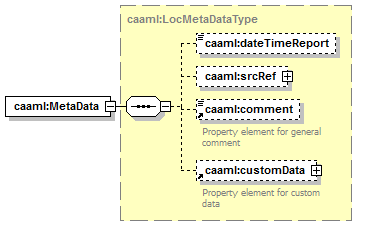 |
||
| namespace | http://caaml.org/Schemas/V5.0/Profiles/BulletinEAWS | ||
| properties |
|
||
| children | caaml:extFiles caaml:customData caaml:comment caaml:highlights | ||
| used by |
|
||
| source | <complexType name="ObsMeasurementsType" abstract="true"> <sequence> <element ref="caaml:extFiles" minOccurs="0"/> <element ref="caaml:customData" minOccurs="0"/> <element ref="caaml:comment" minOccurs="0"/> <element name="highlights" type="string" minOccurs="0"> <annotation> <documentation>Property element for general highlight</documentation> </annotation> </element> </sequence> </complexType> |
| diagram | 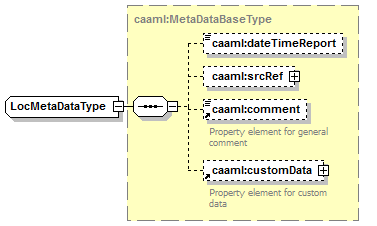 |
||||
| namespace | http://caaml.org/Schemas/V5.0/Profiles/BulletinEAWS | ||||
| type | string | ||||
| properties |
|
||||
| annotation |
|
||||
| source | <element name="highlights" type="string" minOccurs="0"> <annotation> <documentation>Property element for general highlight</documentation> </annotation> </element> |
| diagram |  |
||
| namespace | http://caaml.org/Schemas/V5.0/Profiles/BulletinEAWS | ||
| type | restriction of caaml:MetaDataBaseType | ||
| properties |
|
||
| children | caaml:dateTimeReport caaml:srcRef caaml:comment caaml:customData | ||
| used by |
|
||
| source | <complexType name="ObsMetaDataBaseType"> <complexContent> <restriction base="caaml:MetaDataBaseType"> <sequence> <element name="dateTimeReport" type="gml:TimePositionType"/> <element name="srcRef" type="caaml:SourceRefType"/> <element ref="caaml:comment" minOccurs="0"/> <element ref="caaml:customData" minOccurs="0"/> </sequence> </restriction> </complexContent> </complexType> |
| diagram | 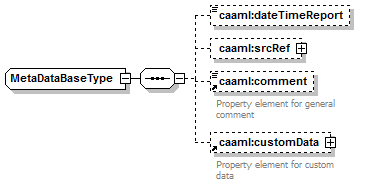 |
||||
| namespace | http://caaml.org/Schemas/V5.0/Profiles/BulletinEAWS | ||||
| type | gml:TimePositionType | ||||
| properties |
|
||||
| source | <element name="dateTimeReport" type="gml:TimePositionType"/> |
| diagram |  |
||||||||||||
| namespace | http://caaml.org/Schemas/V5.0/Profiles/BulletinEAWS | ||||||||||||
| type | caaml:SourceRefType | ||||||||||||
| properties |
|
||||||||||||
| children | caaml:Operation | ||||||||||||
| attributes |
|
||||||||||||
| source | <element name="srcRef" type="caaml:SourceRefType"/> |
| diagram |  |
||
| namespace | http://caaml.org/Schemas/V5.0/Profiles/BulletinEAWS | ||
| type | extension of caaml:ObsMetaDataBaseType | ||
| properties |
|
||
| children | caaml:dateTimeReport caaml:srcRef caaml:comment caaml:customData | ||
| used by |
|
||
| source | <complexType name="ObsMetaDataType"> <complexContent> <extension base="caaml:ObsMetaDataBaseType"/> </complexContent> </complexType> |
| diagram |  |
||||||||||||||
| namespace | http://caaml.org/Schemas/V5.0/Profiles/BulletinEAWS | ||||||||||||||
| children | caaml:metaDataProperty caaml:operations | ||||||||||||||
| used by |
|
||||||||||||||
| attributes |
|
||||||||||||||
| source | <complexType name="OperationCollectionType"> <sequence> <element name="metaDataProperty" minOccurs="0"> <complexType> <sequence> <element name="MetaData" type="caaml:MetaDataBaseType"/> </sequence> </complexType> </element> <element ref="caaml:operations"/> </sequence> <attribute ref="gml:id" use="optional"/> </complexType> |
| diagram |  |
||||
| namespace | http://caaml.org/Schemas/V5.0/Profiles/BulletinEAWS | ||||
| properties |
|
||||
| children | caaml:MetaData | ||||
| source | <element name="metaDataProperty" minOccurs="0"> <complexType> <sequence> <element name="MetaData" type="caaml:MetaDataBaseType"/> </sequence> </complexType> </element> |
| diagram | 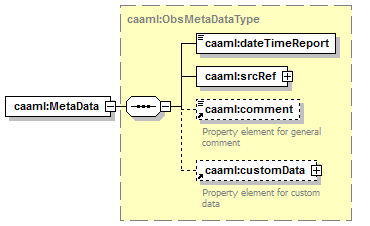 |
||||
| namespace | http://caaml.org/Schemas/V5.0/Profiles/BulletinEAWS | ||||
| type | caaml:MetaDataBaseType | ||||
| properties |
|
||||
| children | caaml:dateTimeReport caaml:srcRef caaml:comment caaml:customData | ||||
| source | <element name="MetaData" type="caaml:MetaDataBaseType"/> |
| diagram | 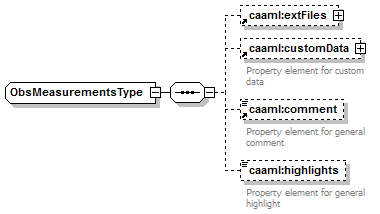 |
||
| namespace | http://caaml.org/Schemas/V5.0/Profiles/BulletinEAWS | ||
| properties |
|
||
| children | caaml:Operation | ||
| source | <complexType name="OperationRefType" final="#all"> <choice> <element ref="caaml:Operation"/> </choice> </complexType> |
| diagram |  |
||||||||||||||
| namespace | http://caaml.org/Schemas/V5.0/Profiles/BulletinEAWS | ||||||||||||||
| type | extension of caaml:SourceType | ||||||||||||||
| properties |
|
||||||||||||||
| children | caaml:customData caaml:name caaml:contactPerson | ||||||||||||||
| used by |
|
||||||||||||||
| attributes |
|
||||||||||||||
| source | <complexType name="OperationType" final="#all"> <complexContent> <extension base="caaml:SourceType"> <sequence> <element name="contactPerson" type="caaml:PersonRefType" minOccurs="0" maxOccurs="unbounded"/> </sequence> </extension> </complexContent> </complexType> |
| diagram | 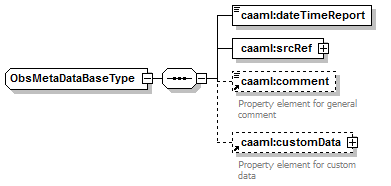 |
||||
| namespace | http://caaml.org/Schemas/V5.0/Profiles/BulletinEAWS | ||||
| type | caaml:PersonRefType | ||||
| properties |
|
||||
| children | caaml:Person | ||||
| source | <element name="contactPerson" type="caaml:PersonRefType" minOccurs="0" maxOccurs="unbounded"/> |
| diagram |  |
||
| namespace | http://caaml.org/Schemas/V5.0/Profiles/BulletinEAWS | ||
| children | caaml:Person | ||
| used by |
|
||
| source | <complexType name="PersonRefType"> <choice> <element ref="caaml:Person"/> </choice> </complexType> |
| diagram |  |
||||||||||||||
| namespace | http://caaml.org/Schemas/V5.0/Profiles/BulletinEAWS | ||||||||||||||
| type | extension of caaml:SourceType | ||||||||||||||
| properties |
|
||||||||||||||
| children | caaml:customData caaml:name | ||||||||||||||
| used by |
|
||||||||||||||
| attributes |
|
||||||||||||||
| source | <complexType name="PersonType" final="#all"> <complexContent> <extension base="caaml:SourceType"/> </complexContent> </complexType> |
| diagram |  |
||||||||||||||
| namespace | http://caaml.org/Schemas/V5.0/Profiles/BulletinEAWS | ||||||||||||||
| properties |
|
||||||||||||||
| children | caaml:metaDataProperty caaml:description caaml:name caaml:regionSubType caaml:centerPoint caaml:outline | ||||||||||||||
| used by |
|
||||||||||||||
| attributes |
|
||||||||||||||
| source | <complexType name="RegionType" final="#all"> <sequence> <element name="metaDataProperty" minOccurs="0"> <annotation> <documentation>Property element for location meta data</documentation> </annotation> <complexType> <sequence> <element name="MetaData" type="caaml:LocMetaDataType"/> </sequence> </complexType> </element> <element name="description" type="string" minOccurs="0"> <annotation> <documentation>Property element for description of location</documentation> </annotation> </element> <element name="name" type="string"> <annotation> <documentation>Property element for name of location</documentation> </annotation> </element> <element name="regionSubType" type="string"> <annotation> <documentation>Required property element for specifying sub type of region (forecast area, drainage,..)</documentation> </annotation> </element> <element name="centerPoint" minOccurs="0"> <annotation> <documentation>Property element for coordinates of center point</documentation> </annotation> <complexType> <sequence> <element ref="gml:Point"/> </sequence> </complexType> </element> <element name="outline" minOccurs="0"> <annotation> <documentation>Property element for coordinates of region outline</documentation> </annotation> <complexType> <sequence> <element ref="gml:Polygon"/> </sequence> </complexType> </element> </sequence> <attribute ref="gml:id" use="required"/> </complexType> |
| diagram |  |
||||
| namespace | http://caaml.org/Schemas/V5.0/Profiles/BulletinEAWS | ||||
| properties |
|
||||
| children | caaml:MetaData | ||||
| annotation |
|
||||
| source | <element name="metaDataProperty" minOccurs="0"> <annotation> <documentation>Property element for location meta data</documentation> </annotation> <complexType> <sequence> <element name="MetaData" type="caaml:LocMetaDataType"/> </sequence> </complexType> </element> |
| diagram |  |
||||
| namespace | http://caaml.org/Schemas/V5.0/Profiles/BulletinEAWS | ||||
| type | caaml:LocMetaDataType | ||||
| properties |
|
||||
| children | caaml:dateTimeReport caaml:srcRef caaml:comment caaml:customData | ||||
| source | <element name="MetaData" type="caaml:LocMetaDataType"/> |
| diagram | 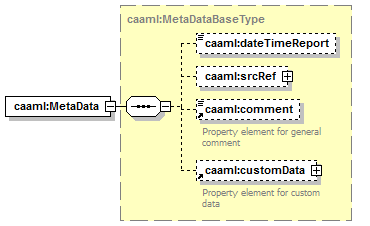 |
||||
| namespace | http://caaml.org/Schemas/V5.0/Profiles/BulletinEAWS | ||||
| type | string | ||||
| properties |
|
||||
| annotation |
|
||||
| source | <element name="description" type="string" minOccurs="0"> <annotation> <documentation>Property element for description of location</documentation> </annotation> </element> |
| diagram |  |
||||
| namespace | http://caaml.org/Schemas/V5.0/Profiles/BulletinEAWS | ||||
| type | string | ||||
| properties |
|
||||
| annotation |
|
||||
| source | <element name="name" type="string"> <annotation> <documentation>Property element for name of location</documentation> </annotation> </element> |
| diagram | 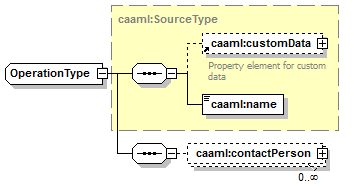 |
||||
| namespace | http://caaml.org/Schemas/V5.0/Profiles/BulletinEAWS | ||||
| type | string | ||||
| properties |
|
||||
| annotation |
|
||||
| source | <element name="regionSubType" type="string"> <annotation> <documentation>Required property element for specifying sub type of region (forecast area, drainage,..)</documentation> </annotation> </element> |
| diagram |  |
||||
| namespace | http://caaml.org/Schemas/V5.0/Profiles/BulletinEAWS | ||||
| properties |
|
||||
| children | gml:Point | ||||
| annotation |
|
||||
| source | <element name="centerPoint" minOccurs="0"> <annotation> <documentation>Property element for coordinates of center point</documentation> </annotation> <complexType> <sequence> <element ref="gml:Point"/> </sequence> </complexType> </element> |
| diagram |  |
||||
| namespace | http://caaml.org/Schemas/V5.0/Profiles/BulletinEAWS | ||||
| properties |
|
||||
| children | gml:Polygon | ||||
| annotation |
|
||||
| source | <element name="outline" minOccurs="0"> <annotation> <documentation>Property element for coordinates of region outline</documentation> </annotation> <complexType> <sequence> <element ref="gml:Polygon"/> </sequence> </complexType> </element> |
| diagram | 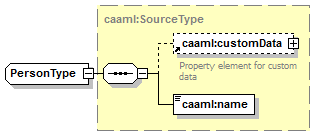 |
||||||||||||
| namespace | http://caaml.org/Schemas/V5.0/Profiles/BulletinEAWS | ||||||||||||
| children | caaml:Operation | ||||||||||||
| used by |
|
||||||||||||
| attributes |
|
||||||||||||
| source | <complexType name="SourceRefType"> <choice minOccurs="0"> <element ref="caaml:Operation"/> </choice> <attribute ref="xlink:href" use="optional"/> </complexType> |
| diagram | 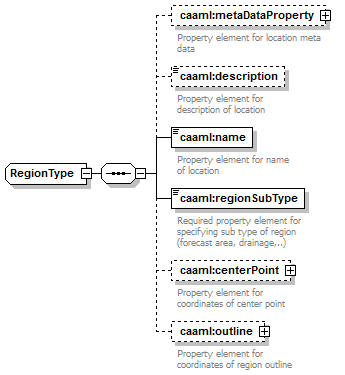 |
||||||||||||||
| namespace | http://caaml.org/Schemas/V5.0/Profiles/BulletinEAWS | ||||||||||||||
| children | caaml:customData caaml:name | ||||||||||||||
| used by |
|
||||||||||||||
| attributes |
|
||||||||||||||
| source | <complexType name="SourceType"> <sequence> <element ref="caaml:customData" minOccurs="0"/> <element name="name" type="string"/> </sequence> <attribute ref="gml:id" use="required"/> </complexType> |
| diagram |  |
||||
| namespace | http://caaml.org/Schemas/V5.0/Profiles/BulletinEAWS | ||||
| type | string | ||||
| properties |
|
||||
| source | <element name="name" type="string"/> |
| diagram | 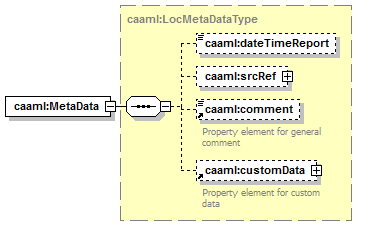 |
||||||||||||||
| namespace | http://caaml.org/Schemas/V5.0/Profiles/BulletinEAWS | ||||||||||||||
| children | caaml:timePosition | ||||||||||||||
| used by |
|
||||||||||||||
| attributes |
|
||||||||||||||
| source | <complexType name="TimeInstantType"> <sequence> <element name="timePosition" type="gml:TimePositionType"/> </sequence> <attribute ref="gml:id" use="optional"/> </complexType> |
| diagram |  |
||||
| namespace | http://caaml.org/Schemas/V5.0/Profiles/BulletinEAWS | ||||
| type | gml:TimePositionType | ||||
| properties |
|
||||
| source | <element name="timePosition" type="gml:TimePositionType"/> |
| diagram |  |
||||||||||||||
| namespace | http://caaml.org/Schemas/V5.0/Profiles/BulletinEAWS | ||||||||||||||
| children | caaml:beginPosition caaml:endPosition | ||||||||||||||
| used by |
|
||||||||||||||
| attributes |
|
||||||||||||||
| source | <complexType name="TimePeriodType"> <sequence> <element name="beginPosition" type="gml:TimePositionType"/> <element name="endPosition" type="gml:TimePositionType"/> </sequence> <attribute ref="gml:id" use="optional"/> </complexType> |
| diagram |  |
||||
| namespace | http://caaml.org/Schemas/V5.0/Profiles/BulletinEAWS | ||||
| type | gml:TimePositionType | ||||
| properties |
|
||||
| source | <element name="beginPosition" type="gml:TimePositionType"/> |
| diagram |  |
||||
| namespace | http://caaml.org/Schemas/V5.0/Profiles/BulletinEAWS | ||||
| type | gml:TimePositionType | ||||
| properties |
|
||||
| source | <element name="endPosition" type="gml:TimePositionType"/> |
| diagram | |||||||||||||
| namespace | http://caaml.org/Schemas/V5.0/Profiles/BulletinEAWS | ||||||||||||
| properties |
|
||||||||||||
| used by |
|
||||||||||||
| attributes |
|
||||||||||||
| source | <complexType name="ValidAspectType" final="#all"> <attribute ref="xlink:href" use="required"/> </complexType> |
| diagram |  |
||||||||||||
| namespace | http://caaml.org/Schemas/V5.0/Profiles/BulletinEAWS | ||||||||||||
| properties |
|
||||||||||||
| children | caaml:ElevationPosition caaml:ElevationRange | ||||||||||||
| used by |
|
||||||||||||
| attributes |
|
||||||||||||
| source | <complexType name="ValidElevationType" final="#all"> <choice minOccurs="0"> <element name="ElevationPosition"> <complexType> <complexContent> <extension base="caaml:ElevationPositionType"/> </complexContent> </complexType> </element> <element name="ElevationRange"> <complexType> <complexContent> <extension base="caaml:ElevationRangeType"/> </complexContent> </complexType> </element> </choice> <attribute ref="xlink:href" use="optional"/> </complexType> |
| diagram |  |
||||||||||||||||||||
| namespace | http://caaml.org/Schemas/V5.0/Profiles/BulletinEAWS | ||||||||||||||||||||
| type | extension of caaml:ElevationPositionType | ||||||||||||||||||||
| properties |
|
||||||||||||||||||||
| children | caaml:position | ||||||||||||||||||||
| attributes |
|
||||||||||||||||||||
| source | <element name="ElevationPosition"> <complexType> <complexContent> <extension base="caaml:ElevationPositionType"/> </complexContent> </complexType> </element> |
| diagram |  |
||||||||||||||||||||
| namespace | http://caaml.org/Schemas/V5.0/Profiles/BulletinEAWS | ||||||||||||||||||||
| type | extension of caaml:ElevationRangeType | ||||||||||||||||||||
| properties |
|
||||||||||||||||||||
| children | caaml:beginPosition caaml:endPosition | ||||||||||||||||||||
| attributes |
|
||||||||||||||||||||
| source | <element name="ElevationRange"> <complexType> <complexContent> <extension base="caaml:ElevationRangeType"/> </complexContent> </complexType> </element> |
| diagram |  |
||
| namespace | http://caaml.org/Schemas/V5.0/Profiles/BulletinEAWS | ||
| properties |
|
||
| children | caaml:TimeInstant caaml:TimePeriod | ||
| used by |
|
||
| source | <complexType name="ValidTimeType" final="#all"> <choice> <element ref="caaml:TimeInstant"/> <element ref="caaml:TimePeriod"/> </choice> </complexType> |
| namespace | http://caaml.org/Schemas/V5.0/Profiles/BulletinEAWS | ||||||||||||||||||
| type | restriction of string | ||||||||||||||||||
| used by |
|
||||||||||||||||||
| facets |
|
||||||||||||||||||
| source | <simpleType name="AspectBaseCardinalType"> <restriction base="string"> <enumeration value="N"/> <enumeration value="NE"/> <enumeration value="E"/> <enumeration value="SE"/> <enumeration value="S"/> <enumeration value="SW"/> <enumeration value="W"/> <enumeration value="NW"/> <enumeration value="n/a"/> </restriction> </simpleType> |
| namespace | http://caaml.org/Schemas/V5.0/Profiles/BulletinEAWS | ||
| type | double | ||
| used by |
|
||
| source | <simpleType name="AspectBaseNumType"> <restriction base="double"/> </simpleType> |
| namespace | http://caaml.org/Schemas/V5.0/Profiles/BulletinEAWS | ||
| type | union of (gml:NilReasonEnumeration, caaml:AspectBaseCardinalType, caaml:AspectBaseNumType) | ||
| used by |
|
||
| source | <simpleType name="AspectBaseType"> <union memberTypes="gml:NilReasonEnumeration caaml:AspectBaseCardinalType caaml:AspectBaseNumType"/> </simpleType> |
| namespace | http://caaml.org/Schemas/V5.0/Profiles/BulletinEAWS | ||||||||||||
| type | restriction of string | ||||||||||||
| used by |
|
||||||||||||
| facets |
|
||||||||||||
| source | <simpleType name="DangerRatingValueBaseType"> <restriction base="string"> <enumeration value="1"/> <enumeration value="2"/> <enumeration value="3"/> <enumeration value="4"/> <enumeration value="5"/> <enumeration value="n/a"/> </restriction> </simpleType> |
| namespace | http://caaml.org/Schemas/V5.0/Profiles/BulletinEAWS | ||
| type | union of (gml:NilReasonEnumeration, caaml:DangerRatingValueBaseType) | ||
| properties |
|
||
| used by |
|
||
| source | <simpleType name="DangerRatingValueType" final="#all"> <union memberTypes="gml:NilReasonEnumeration caaml:DangerRatingValueBaseType"/> </simpleType> |
| namespace | http://caaml.org/Schemas/V5.0/Profiles/BulletinEAWS | ||||
| type | restriction of integer | ||||
| used by |
|
||||
| facets |
|
||||
| source | <simpleType name="ElevationBaseType"> <restriction base="integer"> <minInclusive value="-500"/> <maxInclusive value="9000"/> </restriction> </simpleType> |
| namespace | http://caaml.org/Schemas/V5.0/Profiles/BulletinEAWS | ||||||||||
| type | restriction of string | ||||||||||
| properties |
|
||||||||||
| used by |
|
||||||||||
| facets |
|
||||||||||
| source | <simpleType name="UomLengthType" final="#all"> <restriction base="string"> <enumeration value="cm"/> <enumeration value="mm"/> <enumeration value="m"/> <enumeration value="in"/> <enumeration value="ft"/> </restriction> </simpleType> |
| diagram |  |
||
| namespace | http://www.opengis.net/gml | ||
| type | gml:LinearRingPropertyType | ||
| properties |
|
||
| children | gml:LinearRing | ||
| used by |
|
||
| annotation |
|
||
| source | <element name="exterior" type="gml:LinearRingPropertyType"> <annotation> <documentation>A boundary of a surface consists of a number of rings. In the normal 2D case, one of these rings is distinguished as being the exterior boundary. In a general manifold this is not always possible, in which case all boundaries shall be listed as interior boundaries, and the exterior will be empty.</documentation> </annotation> </element> |
| diagram |  |
||
| namespace | http://www.opengis.net/gml | ||
| type | gml:LinearRingPropertyType | ||
| properties |
|
||
| children | gml:LinearRing | ||
| used by |
|
||
| annotation |
|
||
| source | <element name="interior" type="gml:LinearRingPropertyType"> <annotation> <documentation>A boundary of a surface consists of a number of rings. The "interior" rings separate the surface / surface patch from the area enclosed by the rings.</documentation> </annotation> </element> |
| diagram |  |
||
| namespace | http://www.opengis.net/gml | ||
| type | gml:LinearRingType | ||
| properties |
|
||
| children | gml:posList | ||
| used by |
|
||
| annotation |
|
||
| source | <element name="LinearRing" type="gml:LinearRingType"> <annotation> <documentation>A LinearRing is defined by four or more coordinate tuples, with linear interpolation between them; the first and last coordinates shall be coincident. The number of direct positions in the list shall be at least four.</documentation> </annotation> </element> |
| diagram |  |
||||||||||||||||||||||||||
| namespace | http://www.opengis.net/gml | ||||||||||||||||||||||||||
| type | gml:PointType | ||||||||||||||||||||||||||
| properties |
|
||||||||||||||||||||||||||
| children | gml:pos | ||||||||||||||||||||||||||
| used by |
|
||||||||||||||||||||||||||
| attributes |
|
||||||||||||||||||||||||||
| source | <element name="Point" type="gml:PointType"/> |
| diagram |  |
||||||||||||||||||||||||||
| namespace | http://www.opengis.net/gml | ||||||||||||||||||||||||||
| type | gml:PolygonType | ||||||||||||||||||||||||||
| properties |
|
||||||||||||||||||||||||||
| children | gml:exterior gml:interior | ||||||||||||||||||||||||||
| used by |
|
||||||||||||||||||||||||||
| attributes |
|
||||||||||||||||||||||||||
| annotation |
|
||||||||||||||||||||||||||
| source | <element name="Polygon" type="gml:PolygonType"> <annotation> <documentation>A Polygon is a special surface that is defined by a single surface patch (see D.3.6). The boundary of this patch is coplanar and the polygon uses planar interpolation in its interior. The elements exterior and interior describe the surface boundary of the polygon.</documentation> </annotation> </element> |
| diagram |  |
||
| namespace | http://www.opengis.net/gml | ||
| type | extension of gml:doubleList | ||
| properties |
|
||
| used by |
|
||
| source | <element name="posList"> <complexType> <simpleContent> <extension base="gml:doubleList"/> </simpleContent> </complexType> </element> |
| diagram |  |
||||||||||||||||||||||||
| namespace | http://www.opengis.net/gml | ||||||||||||||||||||||||
| type | extension of string | ||||||||||||||||||||||||
| properties |
|
||||||||||||||||||||||||
| attributes |
|
||||||||||||||||||||||||
| annotation |
|
||||||||||||||||||||||||
| source | <complexType name="CoordinatesType"> <annotation> <documentation>This type is deprecated for tuples with ordinate values that are numbers. CoordinatesType is a text string, intended to be used to record an array of tuples or coordinates. While it is not possible to enforce the internal structure of the string through schema validation, some optional attributes have been provided in previous versions of GML to support a description of the internal structure. These attributes are deprecated. The attributes were intended to be used as follows: Decimal symbol used for a decimal point (default=”.” a stop or period) cs symbol used to separate components within a tuple or coordinate string (default=”,” a comma) ts symbol used to separate tuples or coordinate strings (default=” “ a space) Since it is based on the XML Schema string type, CoordinatesType may be used in the construction of tables of tuples or arrays of tuples, including ones that contain mixed text and numeric values.</documentation> </annotation> <simpleContent> <extension base="string"> <attribute name="decimal" type="string" default="."/> <attribute name="cs" type="string" default=","/> <attribute name="ts" type="string" default=" "/> </extension> </simpleContent> </complexType> |
| diagram |  |
||
| namespace | http://www.opengis.net/gml | ||
| children | gml:LinearRing | ||
| used by |
|
||
| annotation |
|
||
| source | <complexType name="LinearRingPropertyType"> <annotation> <documentation>A property with the content model of gml:LinearRingPropertyType encapsulates a linear ring to represent a component of a surface boundary.</documentation> </annotation> <sequence> <element ref="gml:LinearRing"/> </sequence> </complexType> |
| diagram |  |
||
| namespace | http://www.opengis.net/gml | ||
| children | gml:posList | ||
| used by |
|
||
| source | <complexType name="LinearRingType"> <sequence> <element ref="gml:posList"/> </sequence> </complexType> |
| diagram | 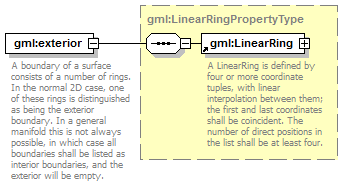 |
||||||||||||||||||||||||||
| namespace | http://www.opengis.net/gml | ||||||||||||||||||||||||||
| children | gml:pos | ||||||||||||||||||||||||||
| used by |
|
||||||||||||||||||||||||||
| attributes |
|
||||||||||||||||||||||||||
| source | <complexType name="PointType"> <sequence> <element name="pos"> <annotation> <documentation>Property element for space-delimited tuple of spatial coordinates of point</documentation> </annotation> <complexType> <simpleContent> <extension base="gml:doubleList"> <attribute name="srsDimension" type="positiveInteger" use="required" fixed="2"/> </extension> </simpleContent> </complexType> </element> </sequence> <attribute ref="gml:id" use="required"/> <attributeGroup ref="gml:SRSReferenceGroup"/> </complexType> |
| diagram | 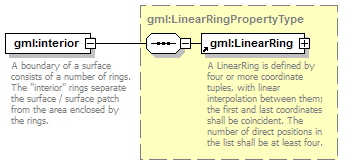 |
||||||||||||
| namespace | http://www.opengis.net/gml | ||||||||||||
| type | extension of gml:doubleList | ||||||||||||
| properties |
|
||||||||||||
| attributes |
|
||||||||||||
| annotation |
|
||||||||||||
| source | <element name="pos"> <annotation> <documentation>Property element for space-delimited tuple of spatial coordinates of point</documentation> </annotation> <complexType> <simpleContent> <extension base="gml:doubleList"> <attribute name="srsDimension" type="positiveInteger" use="required" fixed="2"/> </extension> </simpleContent> </complexType> </element> |
| diagram | 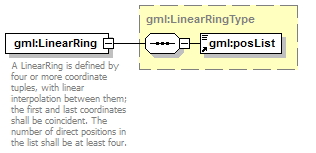 |
||||||||||||||||||||||||||
| namespace | http://www.opengis.net/gml | ||||||||||||||||||||||||||
| children | gml:exterior gml:interior | ||||||||||||||||||||||||||
| used by |
|
||||||||||||||||||||||||||
| attributes |
|
||||||||||||||||||||||||||
| source | <complexType name="PolygonType"> <sequence> <element ref="gml:exterior" minOccurs="0"/> <element ref="gml:interior" minOccurs="0" maxOccurs="unbounded"/> </sequence> <attribute ref="gml:id" use="required"/> <attributeGroup ref="gml:SRSReferenceGroup"/> </complexType> |
| diagram | |||||
| namespace | http://www.opengis.net/gml | ||||
| type | extension of gml:TimePositionUnion | ||||
| properties |
|
||||
| used by |
|
||||
| source | <complexType name="TimePositionType" final="#all"> <simpleContent> <extension base="gml:TimePositionUnion"/> </simpleContent> </complexType> |
| namespace | http://www.opengis.net/gml |
| type | union of (date, gYearMonth, gYear) |
| source | <simpleType name="CalDate"> <union memberTypes="date gYearMonth gYear"/> </simpleType> |
| namespace | http://www.opengis.net/gml | ||
| type | list of double | ||
| used by |
|
||
| annotation |
|
||
| source | <simpleType name="doubleList"> <annotation> <documentation>A type for a list of values of the respective simple type.</documentation> </annotation> <list itemType="double"/> </simpleType> |
| namespace | http://www.opengis.net/gml | ||
| type | union of (restriction of string, restriction of string) | ||
| used by |
|
||
| source | <simpleType name="NilReasonEnumeration"> <union> <simpleType> <restriction base="string"> <enumeration value="inapplicable"/> <enumeration value="missing"/> <enumeration value="template"/> <enumeration value="unknown"/> <enumeration value="withheld"/> </restriction> </simpleType> <simpleType> <restriction base="string"> <pattern value="other:\w{2,}"/> </restriction> </simpleType> </union> </simpleType> |
| namespace | http://www.opengis.net/gml | ||
| type | union of (gml:NilReasonEnumeration, anyURI) | ||
| annotation |
|
||
| source | <simpleType name="NilReasonType"> <annotation> <documentation>gml:NilReasonType defines a content model that allows recording of an explanation for a void value or other exception. gml:NilReasonType is a union of the following enumerated values: - inapplicable there is no value - missing the correct value is not readily available to the sender of this data. Furthermore, a correct value may not exist - template the value will be available later - unknown the correct value is not known to, and not computable by, the sender of this data. However, a correct value probably exists - withheld the value is not divulged - other:text other brief explanation, where text is a string of two or more characters with no included spaces and - anyURI which should refer to a resource which describes the reason for the exception A particular community may choose to assign more detailed semantics to the standard values provided. Alternatively, the URI method enables a specific or more complete explanation for the absence of a value to be provided elsewhere and indicated by-reference in an instance document. gml:NilReasonType is used as a member of a union in a number of simple content types where it is necessary to permit a value from the NilReasonType union as an alternative to the primary type.</documentation> </annotation> <union memberTypes="gml:NilReasonEnumeration anyURI"/> </simpleType> |
| namespace | http://www.opengis.net/gml | ||
| type | restriction of anyURI | ||
| used by |
|
||
| facets |
|
||
| source | <simpleType name="SRSNameRestriction"> <restriction base="anyURI"> <pattern value="urn:ogc:def:crs:OGC:1\.3:CRS84"/> <!--pattern value="urn:ogc:def:crs:OGC:1\.3:AUTO42001:[0-9]{2}:[0-9]{4}"/--> </restriction> </simpleType> |
| namespace | http://www.opengis.net/gml | ||||||||
| type | restriction of string | ||||||||
| facets |
|
||||||||
| annotation |
|
||||||||
| source | <simpleType name="TimeIndeterminateValueType"> <annotation> <documentation>These values are interpreted as follows: - “unknown” indicates that no specific value for temporal position is provided. - “now” indicates that the specified value shall be replaced with the current temporal position whenever the value is accessed. - “before” indicates that the actual temporal position is unknown, but it is known to be before the specified value. - “after” indicates that the actual temporal position is unknown, but it is known to be after the specified value. A value for indeterminatePosition may - be used either alone, or - qualify a specific value for temporal position.</documentation> </annotation> <restriction base="string"> <enumeration value="after"/> <enumeration value="before"/> <enumeration value="now"/> <enumeration value="unknown"/> </restriction> </simpleType> |
| namespace | http://www.opengis.net/gml | ||
| type | union of (date, dateTime) | ||
| used by |
|
||
| annotation |
|
||
| source | <simpleType name="TimePositionUnion"> <annotation> <documentation>The simple type gml:TimePositionUnion is a union of XML Schema simple types which instantiate the subtypes for temporal position described in ISO 19108. An ordinal era may be referenced via URI. A decimal value may be used to indicate the distance from the scale origin . time is used for a position that recurs daily (see ISO 19108:2002 5.4.4.2). Finally, calendar and clock forms that support the representation of time in systems based on years, months, days, hours, minutes and seconds, in a notation following ISO 8601, are assembled by gml:CalDate</documentation> </annotation> <union memberTypes="date dateTime"/> </simpleType> |
| namespace | http://www.opengis.net/gml | ||
| type | union of (gml:UomSymbol, gml:UomURI) | ||
| annotation |
|
||
| source | <simpleType name="UomIdentifier"> <annotation> <documentation>The simple type gml:UomIdentifer defines the syntax and value space of the unit of measure identifier.</documentation> </annotation> <union memberTypes="gml:UomSymbol gml:UomURI"/> </simpleType> |
| namespace | http://www.opengis.net/gml | ||
| type | restriction of string | ||
| used by |
|
||
| facets |
|
||
| annotation |
|
||
| source | <simpleType name="UomSymbol"> <annotation> <documentation>This type specifies a character string of length at least one, and restricted such that it must not contain any of the following characters: “:” (colon), “ “ (space), (newline), (carriage return), (tab). This allows values corresponding to familiar abbreviations, such as “kg”, “m/s”, etc. It is recommended that the symbol be an identifier for a unit of measure as specified in the “Unified Code of Units of Measure" (UCUM) (http://aurora.regenstrief.org/UCUM). This provides a set of symbols and a grammar for constructing identifiers for units of measure that are unique, and may be easily entered with a keyboard supporting the limited character set known as 7-bit ASCII. ISO 2955 formerly provided a specification with this scope, but was withdrawn in 2001. UCUM largely follows ISO 2955 with modifications to remove ambiguities and other problems.</documentation> </annotation> <restriction base="string"> <pattern value="[^: \n\r\t]+"/> </restriction> </simpleType> |
| namespace | http://www.opengis.net/gml | ||
| type | restriction of anyURI | ||
| used by |
|
||
| facets |
|
||
| annotation |
|
||
| source | <simpleType name="UomURI"> <annotation> <documentation>This type specifies a URI, restricted such that it must start with one of the following sequences: “#”, “./”, “../”, or a string of characters followed by a “:”. These patterns ensure that the most common URI forms are supported, including absolute and relative URIs and URIs that are simple fragment identifiers, but prohibits certain forms of relative URI that could be mistaken for unit of measure symbol . NOTE It is possible to re-write such a relative URI to conform to the restriction (e.g. “./m/s”). In an instance document, on elements of type gml:MeasureType the mandatory uom attribute shall carry a value corresponding to either - a conventional unit of measure symbol, - a link to a definition of a unit of measure that does not have a conventional symbol, or when it is desired to indicate a precise or variant definition.</documentation> </annotation> <restriction base="anyURI"> <pattern value="([a-zA-Z][a-zA-Z0-9\-\+\.]*:|\.\./|\./|#).*"/> </restriction> </simpleType> |
| namespace | http://www.opengis.net/gml | ||||||||||||||||||
| used by |
|
||||||||||||||||||
| attributes |
|
||||||||||||||||||
| annotation |
|
||||||||||||||||||
| source | <attributeGroup name="SRSReferenceGroup"> <annotation> <documentation>The attribute group SRSReferenceGroup is an optional reference to the CRS used by this geometry, with optional additional information to simplify the processing of the coordinates when a more complete definition of the CRS is not needed. In general the attribute srsName points to a CRS instance of gml:AbstractCoordinateReferenceSystem. For well-known references it is not required that the CRS description exists at the location the URI points to. If no srsName attribute is given, the CRS shall be specified as part of the larger context this geometry element is part of.</documentation> </annotation> <attribute name="srsName" type="gml:SRSNameRestriction" use="required" fixed="urn:ogc:def:crs:OGC:1.3:CRS84"/> <attribute name="srsDimension" type="positiveInteger" use="required" fixed="2"/> </attributeGroup> |
| namespace | http://www.w3.org/1999/xlink | ||||||||||||||||||||||||||||||||||||||||||||||||||||
| attributes |
|
||||||||||||||||||||||||||||||||||||||||||||||||||||
| source | <attributeGroup name="arcLink"> <attribute name="type" type="string" fixed="arc" form="qualified"/> <attribute ref="xlink:arcrole" use="optional"/> <attribute ref="xlink:title" use="optional"/> <attribute ref="xlink:show" use="optional"/> <attribute ref="xlink:actuate" use="optional"/> <attribute ref="xlink:from" use="optional"/> <attribute ref="xlink:to" use="optional"/> </attributeGroup> |
| namespace | http://www.w3.org/1999/xlink | ||||||||||||
| attributes |
|
||||||||||||
| source | <attributeGroup name="emptyLink"> <attribute name="type" type="string" fixed="none" form="qualified"/> </attributeGroup> |
| namespace | http://www.w3.org/1999/xlink | ||||||||||||||||||||||||
| attributes |
|
||||||||||||||||||||||||
| source | <attributeGroup name="extendedLink"> <attribute name="type" type="string" fixed="extended" form="qualified"/> <attribute ref="xlink:role" use="optional"/> <attribute ref="xlink:title" use="optional"/> </attributeGroup> |
| namespace | http://www.w3.org/1999/xlink | ||||||||||||||||||||||||||||||||||||
| attributes |
|
||||||||||||||||||||||||||||||||||||
| source | <attributeGroup name="locatorLink"> <attribute name="type" type="string" fixed="locator" form="qualified"/> <attribute ref="xlink:href" use="required"/> <attribute ref="xlink:role" use="optional"/> <attribute ref="xlink:title" use="optional"/> <attribute ref="xlink:label" use="optional"/> </attributeGroup> |
| namespace | http://www.w3.org/1999/xlink | ||||||||||||||||||||||||||||||
| attributes |
|
||||||||||||||||||||||||||||||
| source | <attributeGroup name="resourceLink"> <attribute name="type" type="string" fixed="resource" form="qualified"/> <attribute ref="xlink:role" use="optional"/> <attribute ref="xlink:title" use="optional"/> <attribute ref="xlink:label" use="optional"/> </attributeGroup> |
| namespace | http://www.w3.org/1999/xlink | ||||||||||||||||||||||||||||||||||||||||||||||||||||
| attributes |
|
||||||||||||||||||||||||||||||||||||||||||||||||||||
| source | <attributeGroup name="simpleLink"> <attribute name="type" type="string" fixed="simple" form="qualified"/> <attribute ref="xlink:href" use="optional"/> <attribute ref="xlink:role" use="optional"/> <attribute ref="xlink:arcrole" use="optional"/> <attribute ref="xlink:title" use="optional"/> <attribute ref="xlink:show" use="optional"/> <attribute ref="xlink:actuate" use="optional"/> </attributeGroup> |
| namespace | http://www.w3.org/1999/xlink | ||||||||||||
| attributes |
|
||||||||||||
| source | <attributeGroup name="titleLink"> <attribute name="type" type="string" fixed="title" form="qualified"/> </attributeGroup> |